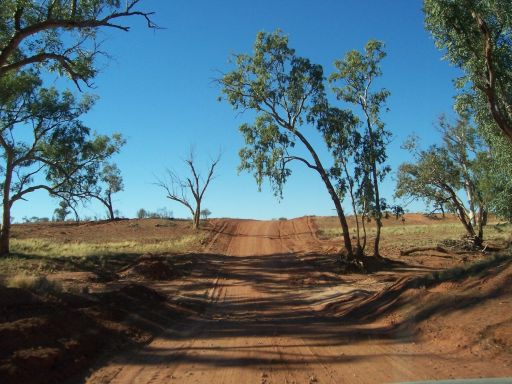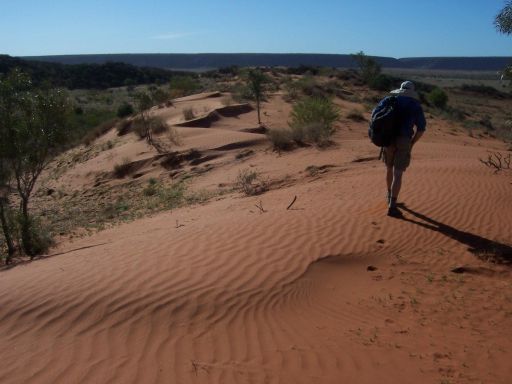Jani Radebaugh • Jul 29, 2009
Dunes in the Outback Red Center
For the next few days, I want to talk a bit about an important aspect of planetary studies: understanding analogs we can easily visit on Earth to processes happening across the solar system. We all understand how expensive and difficult (but rewarding!) it is to explore other planets. Often, we can only obtain small amounts of data, sometimes in the form of images, of objects or processes in the solar system, and from these limited data we must try to understand what is going on as best we can. Yet we have seen that a combined study of the same actions occurring in different locations helps us understand the science behind the process. Fortunately, we live on one of the most diverse and interesting planets in the solar system, planet Earth. Here, we can find most of the processes we study on other bodies, usually occurring at different rates, scales, and with different materials. Since it's much easier to access these processes on Earth, we spend time finding and studying these locations worldwide.
Recently, I returned from a trip to the Australian Outback, where we went in search of analogs to an important feature on the surface of Titan -- dunes. There are tens of thousands of dunes on Titan, all of a certain form known as linear, since they line up parallel to each other. This kind of dune is also common on Earth, although it is mainly found in the Saharan, Namibian, and Saudi Arabian deserts. Some are also found in a dormant state in China and Australia. In fact, much of Australia's vast central deserts are covered in linear dunes, most of them formed tens of thousands of years ago, when the planet was drier and winds carried lots of sediments around. We went in search of the best and most accessible spots to climb around on the dunes and try to figure out what made them tick (in the past, that is).
Note that driving in the Australian Outback is a lot like driving through the US desert southwest: there is lots of red dirt and even some hardy desert vegetation. So we felt right at home, since we've spent a lot of time in Arizona and Utah.
We reached our destination without incident (we won't discuss the flat tire at another far-flung location that we did manage to limp out of...) and found what we were looking for -- lots of dunes. Typically, linear dunes are quite large, from 1-2 km across and spaced by as much. These Australian dunes, however, are much smaller, because of wind and sand conditions at the time of their formation. Here you can see Ralph Lorenz walking on the summit crest of one of the linear dunes. Several things are apparent in this image of the dune. First, the dunes are heavily vegetated, meaning they are no longer actively forming and moving. The crest of the dune, however, is active, as you can see by the ripples and a sharp dune crest. You can see the broad dune profile (Ralph is walking down the dune long axis), indicating winds probably blew obliquely across the dune from alternating directions, as many models predict. This dune was funneled through two mountains as winds blew generally from the south (we face south in this picture) to the north. We see many of these features in dunes on Titan on a bigger scale, so it was valuable for us to walk on the dunes and see what happens as they come close to mountains and other obstacles.
Something else we could do in the Outback that is not yet possible for us to do on Titan is to pick up the dune sediments and look at them up close. The particles are fine, "sand"-sized, and therefore easily lifted and transported by the wind. If the particles are too small, they'll just be blown away as dust, and if too big, they won't ever be lifted. But this size is just right for rolling and jumping (saltating) from wind action. Because of wind models and gravity, we think the sands of Titan are fairly similar in size. But what are they made of? We know they are not made of these deep red, oxidized, silicate sands found in Australia's Red Center, but we are not yet sure what we would pick up were we on Titan. It's likely Titan's sands would contain lots of hydrocarbons, a product of photochemical processes occurring in the upper atmosphere. But how are these particles eroded or altered to become the correct size for saltation and dune formation? We'll continue to seek for answers to these questions through Cassini's many capable instruments and other scientific models.
Visiting these kinds of analog locations on Earth brings us another step closer to understanding the winds and sediments of the faraway satellite of Saturn.


 Explore Worlds
Explore Worlds Find Life
Find Life Defend Earth
Defend Earth




